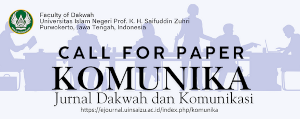Dakwah di Era Digital
DOI:
https://doi.org/10.24090/komunika.v11i2.1369Keywords:
Dakwah, Globalization, Digital eraAbstract
These days dakwah is not only interpreted as transformation of a pure religious value, but also transformation of a more relevant value including many aspects in digital era. Digital era is when society succumbed into the flow of information causing cultural shock and difficulties on synthesizing meaning from those scattered information. Dakwah on Digital age must accommodate societal needs which tend to move into a mass society. It results in strategy and more humane and innovative dakwah methods. One of innovative dakwah methods is conducted dakwah activities through digital media,with the consequences of this is that da’i must developed soft skill and technological capabilities. Another beneficial comes from this is that dakwah could become more modern and practical in terms of methods and material. On the other hand, citizen Journalism as a mass cultural product and the results of technological development, gives an opportunity for da’i to able to record the entire activities, including the dynamics of islamic life. In terms of learning curriculum, dakwah in digital format must be included, so then the intellectual and cultural spirit which flourished in pesantren could be adapted and competed in a global world.Downloads
Download data is not yet available.
References
(ed), I. S. (2005). Media dan Citra Muslim. Yogyakarta: Jalasutra.
Barker, C. (2009). Cultural Studies. Yogyakarta: Tiara Wacana.
Basit, A. (2006). Wacana Dakwah Kontemporer. Yogyakarta: Pustaka Pelajar.
Basit, A. (2008). Dakwah Antar Individu Teori dan Aplikasi. Yogyakarta: Grafindo Litera Media.
Basit, A. (2013). Dakwah Cerdas di Era Modern. Jurnal Komunikasi Islam.
Basit, A. (2013). Filsafat Dakwah. Jakarta: Raja Grafindo.
Habermas, J. (2007). Rasio dan Rasionalisasi Masyarakat. Yogyakarta: Kreasi Wacana.
Hardiman, F. B. (1993). Menuju Masyarakat Komunikatif: Ilmu, Masyarakat, Politik dan Postmodernisme Menurut Jurgen Habermas. Yogyakarta: Kanisius.
Ilaihi, W., & Hefni, H. (2015). Pengantar Sejarah Dakwah. Jakarta: Prenada Media.
Meilani. (2014). Berbudaya Melalui Media Digital. Jurnal Humaniora, 5(2).
Mulkhan, A. M. (1996). Ideologisasi Gerakan Dakwah Episode Kehidupan M. Natsir dan Azhar Basyir. Yogyakarta: Sipress.
Piliang, Y. A. (2004). Dunia yang Dilipat Tamasya Melampaui Batas-batas Kebudayaan. Yogyakarta: Jalasutra.
Rajab, M. (2014). Dakwah dan Tantangannya dalam Media Teknologi Komunikasi. Jurnal Dakwah Tabligh, 15 (1).
Robiah, T. S. (2013). Analysis of Rampak Bedug Arts as Media on Da’wa in Banten. Jurnal Bimas Islam.
Setiana, W. (2011). Revitalisasi Dakwah dalam Menghadapi Dampak Budaya Global di Indonesia. Jurnal Ilmu Dakwah.
Shihab, M. Q. (2006). Menabur Pesan Ilahi. Jakarta: Lentera Hati.
Susana, T. (2012). Kesetiaan pada Panggilan di Era Digital. Jurnal orientasi Baru.
Suseno, F. M., & dkk. (2007). Memahami Hubungan Antar Agama. Yogyakarta: Sukses Offset.
Taufik, M. T. (2013). Dakwah Era Digital. Kuningan: Pustaka Al-Ikhlas.
Yoga, S. S. (2015). Dakwah di Internet: Konsep Ideal, Kondisi Objektif, dan Prospeknya. Jurnal Al Bayan.
Zada, K., & dkk. (2006). Pemahaman Keagamaan Kelompok Islam Radikal Terhadap Pengembangan Multikulturalisme. Jurnal Penelitian Islam.
Barker, C. (2009). Cultural Studies. Yogyakarta: Tiara Wacana.
Basit, A. (2006). Wacana Dakwah Kontemporer. Yogyakarta: Pustaka Pelajar.
Basit, A. (2008). Dakwah Antar Individu Teori dan Aplikasi. Yogyakarta: Grafindo Litera Media.
Basit, A. (2013). Dakwah Cerdas di Era Modern. Jurnal Komunikasi Islam.
Basit, A. (2013). Filsafat Dakwah. Jakarta: Raja Grafindo.
Habermas, J. (2007). Rasio dan Rasionalisasi Masyarakat. Yogyakarta: Kreasi Wacana.
Hardiman, F. B. (1993). Menuju Masyarakat Komunikatif: Ilmu, Masyarakat, Politik dan Postmodernisme Menurut Jurgen Habermas. Yogyakarta: Kanisius.
Ilaihi, W., & Hefni, H. (2015). Pengantar Sejarah Dakwah. Jakarta: Prenada Media.
Meilani. (2014). Berbudaya Melalui Media Digital. Jurnal Humaniora, 5(2).
Mulkhan, A. M. (1996). Ideologisasi Gerakan Dakwah Episode Kehidupan M. Natsir dan Azhar Basyir. Yogyakarta: Sipress.
Piliang, Y. A. (2004). Dunia yang Dilipat Tamasya Melampaui Batas-batas Kebudayaan. Yogyakarta: Jalasutra.
Rajab, M. (2014). Dakwah dan Tantangannya dalam Media Teknologi Komunikasi. Jurnal Dakwah Tabligh, 15 (1).
Robiah, T. S. (2013). Analysis of Rampak Bedug Arts as Media on Da’wa in Banten. Jurnal Bimas Islam.
Setiana, W. (2011). Revitalisasi Dakwah dalam Menghadapi Dampak Budaya Global di Indonesia. Jurnal Ilmu Dakwah.
Shihab, M. Q. (2006). Menabur Pesan Ilahi. Jakarta: Lentera Hati.
Susana, T. (2012). Kesetiaan pada Panggilan di Era Digital. Jurnal orientasi Baru.
Suseno, F. M., & dkk. (2007). Memahami Hubungan Antar Agama. Yogyakarta: Sukses Offset.
Taufik, M. T. (2013). Dakwah Era Digital. Kuningan: Pustaka Al-Ikhlas.
Yoga, S. S. (2015). Dakwah di Internet: Konsep Ideal, Kondisi Objektif, dan Prospeknya. Jurnal Al Bayan.
Zada, K., & dkk. (2006). Pemahaman Keagamaan Kelompok Islam Radikal Terhadap Pengembangan Multikulturalisme. Jurnal Penelitian Islam.
Downloads
Published
2018-04-13
Issue
Section
Articles
License
Authors who publish with this journal agree to the following terms:
- Authors retain copyright and grant the journal right of first publication with the work simultaneously licensed under a Creative Commons Attribution-ShareAlike 4.0 International License that allows others to share the work with an acknowledgement of the work's authorship and initial publication in this journal.
- Authors are able to enter into separate, additional contractual arrangements for the non-exclusive distribution of the journal's published version of the work (e.g., post it to an institutional repository or publish it in a book), with an acknowledgement of its initial publication in this journal.
- Authors are permitted and encouraged to post their work online (e.g., in institutional repositories or on their website) prior to and during the submission process, as it can lead to productive exchanges, as well as earlier and greater citation of published work (See The Effect of Open Access).

























